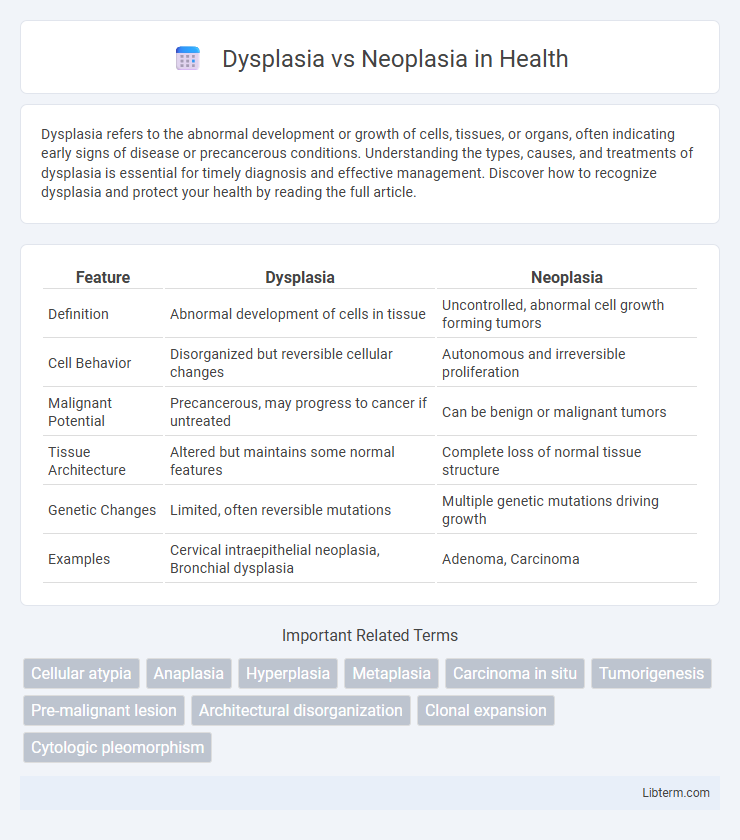Dysplasia refers to the abnormal development or growth of cells, tissues, or organs, often indicating early signs of disease or precancerous conditions. Understanding the types, causes, and treatments of dysplasia is essential for timely diagnosis and effective management. Discover how to recognize dysplasia and protect your health by reading the full article.
Table of Comparison
| Feature | Dysplasia | Neoplasia |
|---|---|---|
| Definition | Abnormal development of cells in tissue | Uncontrolled, abnormal cell growth forming tumors |
| Cell Behavior | Disorganized but reversible cellular changes | Autonomous and irreversible proliferation |
| Malignant Potential | Precancerous, may progress to cancer if untreated | Can be benign or malignant tumors |
| Tissue Architecture | Altered but maintains some normal features | Complete loss of normal tissue structure |
| Genetic Changes | Limited, often reversible mutations | Multiple genetic mutations driving growth |
| Examples | Cervical intraepithelial neoplasia, Bronchial dysplasia | Adenoma, Carcinoma |
Introduction to Dysplasia and Neoplasia
Dysplasia refers to the abnormal development or disordered growth of cells within tissues, often indicating a premalignant condition with potential to progress to cancer. Neoplasia involves the uncontrolled, abnormal proliferation of cells resulting in a neoplasm or tumor, which can be benign or malignant. Understanding the cellular and histological distinctions between dysplasia and neoplasia is critical for accurate diagnosis and effective treatment planning in pathology.
Defining Dysplasia: Key Characteristics
Dysplasia is characterized by the presence of abnormal cells within a tissue, showing irregular size, shape, and organization but lacking invasive growth typical of cancer. It represents a reversible precancerous condition often caused by chronic irritation or inflammation, marked by disordered cellular maturation and increased mitotic activity. Unlike neoplasia, dysplasia does not form a true tumor mass or exhibit autonomous growth, distinguishing it as a distinct pathological process with potential progression to malignancy if untreated.
Understanding Neoplasia: Essential Features
Neoplasia is characterized by uncontrolled, abnormal cell growth that forms a mass called a neoplasm, which can be benign or malignant. Unlike dysplasia, which represents disordered but reversible cellular changes confined to the epithelium, neoplasia involves genetic mutations leading to autonomous cell proliferation independent of normal regulatory signals. Key features include clonal expansion, invasiveness in malignant forms, and the potential for metastasis, distinguishing neoplasia as a fundamental process in cancer development.
Cellular Changes in Dysplasia vs Neoplasia
Dysplasia is characterized by disorganized cellular architecture with abnormal cell size, shape, and nuclear features, often reflecting a reversible premalignant stage. Neoplasia involves autonomous, uncontrolled cell proliferation resulting in the formation of benign or malignant tumors with altered cellular differentiation and genetic mutations. Cellular changes in neoplasia typically include increased mitotic figures, loss of normal tissue architecture, and potential invasion into adjacent tissues.
Causes and Risk Factors
Dysplasia arises from chronic inflammation, persistent irritation, or genetic mutations causing abnormal cell growth, often seen in tissues exposed to carcinogens like tobacco smoke or human papillomavirus infection. Neoplasia results from genetic alterations in oncogenes and tumor suppressor genes, leading to uncontrolled cell proliferation independent of normal regulatory mechanisms, with risk factors including exposure to carcinogens, radiation, and inherited genetic predispositions. Both conditions share overlapping causes such as DNA damage and environmental exposures but differ in the extent of cellular abnormality and progression toward malignancy.
Clinical Presentation and Symptoms
Dysplasia often presents with localized epithelial changes detectable through biopsy, typically asymptomatic but may cause mild irritation or abnormal tissue appearance in areas like the cervix or oral mucosa. Neoplasia manifests with more pronounced symptoms depending on tumor location and size, including palpable masses, pain, bleeding, or organ dysfunction in advanced stages. Early detection relies on clinical examination and imaging, as both conditions can initially lack overt symptoms, highlighting the importance of screening in high-risk populations.
Diagnostic Techniques and Criteria
Dysplasia is characterized by abnormal cellular architecture and maturation limited to epithelial tissue, often diagnosed through histopathological examination using biopsy and graded by the degree of atypia and tissue disorganization. Neoplasia involves uncontrolled, clonal proliferation of cells forming benign or malignant tumors and requires immunohistochemistry, molecular markers, and imaging techniques like MRI or CT for precise characterization and staging. Diagnostic criteria for dysplasia focus on cellular irregularities without invasion, whereas neoplasia diagnosis hinges on identifying invasive growth patterns and genetic mutations.
Progression: From Dysplasia to Neoplasia
Dysplasia represents an abnormal but potentially reversible proliferation of cells with disordered architecture, often considered a precancerous stage that can progress to neoplasia if genetic mutations accumulate. Neoplasia involves uncontrolled and irreversible cell growth characterized by autonomous proliferation and loss of normal regulatory mechanisms, typically resulting from the transformation of dysplastic cells. The progression from dysplasia to neoplasia is driven by molecular alterations such as mutations in tumor suppressor genes and oncogenes, leading to invasive cancer development.
Treatment Options and Management Strategies
Dysplasia management primarily involves monitoring with regular biopsies and eliminating underlying causes such as infections or irritants to prevent progression to cancer. Neoplasia treatment varies based on tumor type, size, and stage, typically including surgical excision, radiation therapy, chemotherapy, or targeted therapies to control or eradicate malignant growths. Early detection and precise histopathological evaluation guide tailored treatment plans improving patient prognosis in both conditions.
Prognosis and Prevention
Dysplasia, characterized by abnormal but potentially reversible cellular changes, generally has a better prognosis when detected early and managed appropriately through lifestyle modifications and regular screening. Neoplasia involves uncontrolled, often irreversible cell proliferation with a higher risk of malignancy, necessitating more aggressive treatment and ongoing surveillance to improve survival outcomes. Preventive strategies for dysplasia include addressing underlying risk factors such as infections or chronic irritation, while neoplasia prevention emphasizes early detection through screening programs and minimizing exposure to carcinogens like tobacco and radiation.
Dysplasia Infographic

 libterm.com
libterm.com